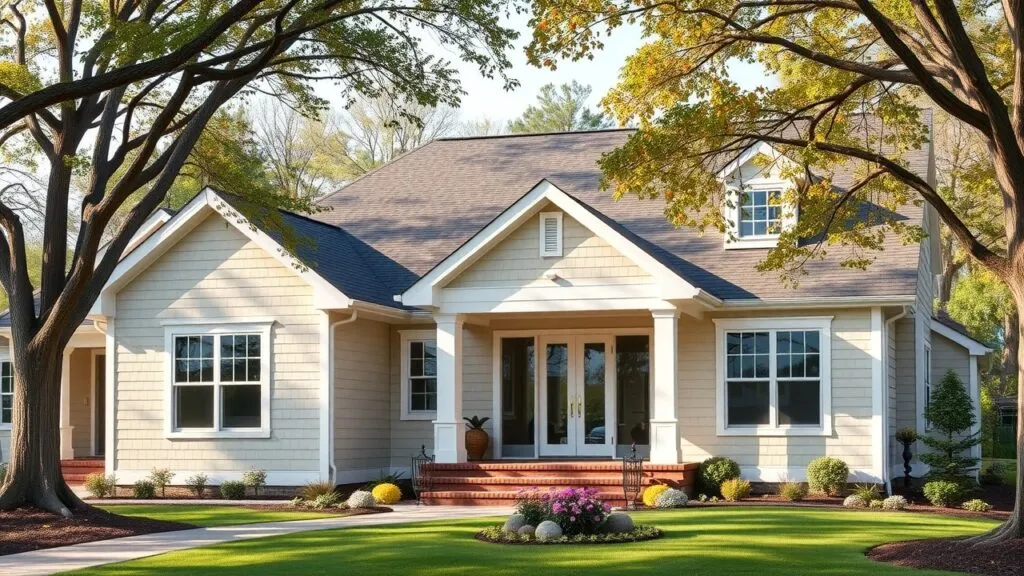This guide covers popular types of home styles, detailing architectural styles like Ranch and Victorian. Explore different house styles and types of homes to find your ideal home design.
What is a Home Style?

A home style is the unique look and design features that make different houses special. These styles come from history, culture, and where a house is built. Common house styles include Colonial, Victorian, Ranch, Craftsman, Cape Cod, and Modern. Each has its own traits. For example:
- Colonial Styles: These are known for their balanced and neat designs.
- Victorian Styles: They stand out with detailed decorations and bright colors.
- Ranch Styles: These homes have long shapes and spacious layouts.
When people learn about these architectural styles, they see how their own homes fit into the bigger picture of residential architecture. Knowing these features helps people appreciate what makes a house beautiful and understand more about the style they might want if buying a new home.
Why Understanding Home Styles Matters?
Knowing about home styles is important for many reasons. First, it can influence property value. Some styles are more popular in certain areas than others. Buyers often prefer homes that match current trends or have a classic look.
For those who want to renovate their homes, understanding home styles helps them choose improvements that look good while keeping the home’s original charm. Real estate agents also gain from this knowledge since accurately describing a home’s style can attract buyers who are looking for specific features.
People who love architecture can connect better with their communities when they know about different building styles throughout history. This knowledge encourages the preservation of local heritage.
Home Styles Covered in This Guide
In this guide, we will look at several popular home styles you might find in neighborhoods today:
- Colonial Styles
- Victorian Styles
- Ranch Styles
- Craftsman Styles
- Cape Cod Styles
- Modern Home Styles
Each section will cover key traits of these types of homes and offer examples of how they appear in various regions. This resource is great for anyone interested in buying new properties or just wanting to learn more about different kinds of houses in their area.
Colonial Home Styles
Key Features of Colonial Homes
Colonial homes are famous for their classic designs. They often have a rectangular shape and symmetrical layouts. Common features include steeply pitched roofs and evenly spaced windows. You’ll see exteriors made from brick or wood siding, usually painted in soft colors. A central front door with sidelights and a decorative crown is a standout feature.
Here are other key features:
- Chimneys: Often located at both ends of the house.
- Dormer Windows: Found on upper levels for light and ventilation.
- Porches: Many colonial homes have inviting porches that improve curb appeal.
These elements give colonial styles their timeless charm.
Types of Colonial Homes
There are different types of colonial homes that show various regional influences:
- Georgian Style: This style, popular in the 18th century, is known for its formal symmetry, multi-pane sash windows, and decorative cornices. Georgian homes often feature elaborate doorways with pilasters.
- Dutch Colonial: Recognizable by their gambrel roofs, Dutch Colonial houses have wide eaves that extend over porches. They blend stonework with wooden structures nicely.
- Spanish Colonial: These homes showcase stucco exteriors, red-tiled roofs, arched doorways, and wrought iron details that reflect Mediterranean styles found in warmer climates.
Each type has unique architectural features while keeping core characteristics typical of colonial design.
Georgian Style
Georgian homes shine due to their nice proportions and classic detailing inspired by ancient Roman architecture. Common features include:
- Symmetrical facades with an equal number of windows beside a centered entrance.
- Decorative moldings around doors and windows.
- Brick construction accented with white trim.
This style was significant during King George’s reign (1714–1830) and remains a favorite today among those looking for stately residential options.
Dutch Colonial
Dutch colonial houses stand out because of their broad profiles created by gambrel roofing systems. This allows for roomy upper floors without losing charm. Notable aspects include:
- Large front porches held up by columns.
- Multi-paned double-hung windows providing plenty of natural light.
This style reflects early American history influenced by Dutch settlers mainly in areas like New York during the 17th century.
Spanish Colonial
Spanish colonial homes bring warmth through earthy tones and intricate tile work. They flourished especially in regions affected by Spain’s history in North America, like California and Florida:
- Thick adobe walls help keep temperatures stable in southern climates.
- Courtyards surrounded by lush gardens offer great outdoor living spaces.
Architectural elements like arches not only create beauty but also enhance airflow to cool interiors naturally.
Colonial Home Examples & History
You can find many examples of colonial homes across neighborhoods in the U.S., from historic districts with buildings dating back centuries to modern constructions inspired by traditional designs.
The history behind these architectures shows much about values from the past, highlighting family unity through communal spaces like centrally located dining rooms near kitchens—a cherished trait today!
Pros and Cons of Colonial Homes
When thinking about buying a colonial home—or any home—it’s wise to look at both benefits and drawbacks:
Pros:
- Timeless Appeal: Their classic looks keep value over time, attracting various buyers who want long-term stability.
- Spacious Layouts: Typically offering generous space for families regardless of size needs.
- Strong Resale Value Potential due to consistent popularity trends in established housing markets across the country!
Cons:
- Maintenance Costs may be higher depending on materials used during construction needing regular upkeep to keep everything safe.
- Energy Efficiency varies greatly since older builds may lack modern insulation leading to increased utility bills unless upgraded accordingly!
With this information in mind, you can better understand the unique charm and potential challenges of colonial homes!
Victorian Home Styles

Key Features of Victorian Homes
Victorian homes are famous for their special architectural features. They have ornate details that reflect the artistic style of the time. You’ll notice intricate woodwork and decorative trim that add charm. A standout characteristic is the asymmetrical design; these homes don’t follow a uniform shape.
Gingerbread trim is another popular feature. It gives an elaborate look to eaves and porches. Many Victorian houses include towers or turrets, adding height and visual interest. All these elements create a unique character in Victorian home styles.
Types of Victorian Homes
There are several well-known types of Victorian architecture:
- Queen Anne: This style mixes different materials and textures. Queen Anne homes usually have turrets, wraparound porches, and large bay windows, making them inviting.
- Italianate: Known for tall windows with decorative brackets, Italianate houses often have wide eaves supported by corbels. They resemble stately Italian villas.
- Gothic Revival: This style showcases pointed arches and detailed doors and windows. Gothic Revival homes often have steeply pitched roofs and ornamental woodwork, reflecting medieval designs.
Victorian Home Examples & History
Many notable examples of historical home styles can be seen across the U.S.:
- The Painted Ladies in San Francisco show off Queen Anne architecture with their bright colors.
- Frank Lloyd Wright’s Robie House reflects a shift within this genre while keeping Gothic Revival traits.
The Industrial Revolution in the 19th century greatly influenced these designs. Mass production allowed for more elaborate decoration than ever before.
Pros and Cons of Victorian Homes
Owning a Victorian home has both perks and drawbacks:
One big perk is their unique looks—these houses stand out because of their rich history and detailed craftsmanship compared to modern designs. But, potential buyers should think about maintenance issues in historic homes; older materials can need lots of repairs or replacements.
Energy efficiency can also be a problem since many original features don’t meet today’s insulation standards. This often leads to higher utility bills over time. Property values can change based on location but usually remain steady due to demand for distinct architectural styles among buyers who want character-filled homes.
Understanding different home styles helps future homeowners appreciate what makes each one special while also considering practical aspects related to ownership.
Ranch, Craftsman, & Cape Cod Styles
Ranch Home Styles
Ranch homes are well-liked because they’re practical and spacious. These single-story styles often have low-pitched roofs and attached garages.
Key Features of Ranch Homes
Ranch homes stand out with their symmetrical design that creates an open feel. Large windows let in lots of natural light and connect the inside to the outdoors. The open floor plans make it easy to move around and are great for families and gatherings.
Variations of Ranch Homes
There are two main types of ranch homes:
- Raised Ranch: This type raises the main living area off the ground, allowing extra space below.
- Split-Level Ranch: This style has different levels linked by short staircases, offering separate spaces without needing a lot of land.
Pros & Cons of Ranch Homes
Pros: A big plus is accessibility; being single-story means easy movement for everyone. They are also easier to maintain because they usually have simpler roof designs and fewer levels.
Cons: On the flip side, ranch homes can have limited square footage. This can be a problem for larger families needing more space. Additionally, they might not have as much architectural variety compared to multi-level homes.
Craftsman Home Styles
Craftsman-style houses are known for their unique looks and handcrafted details. They grew from the Arts and Crafts movement, focusing on quality and simplicity.
Key Features of Craftsman Homes
Craftsman homes are famous for features like exposed rafters under wide eaves and built-in furniture made from wood. These designs emphasize craftsmanship over mass production.
Historical Context and Origins
Craftsman architecture began in the early 20th century as part of the Arts and Crafts movement in America. It aimed to combine simple designs with artistic touches as a response to industrialization’s cold nature.
Pros & Cons of Craftsman Homes
Pros: Many buyers love Craftsman homes for their unique charm compared to modern designs.
Cons: However, they may require more maintenance because wooden materials need regular care to avoid issues like moisture damage or pests.
Cape Cod Home Styles
Cape Cod houses offer simple yet effective designs suited for coastal areas where they first appeared during colonial times in New England.
Key Features of Cape Cod Homes
These homes usually feature steep rooflines that help shed snow easily. Dormer windows add light to upper floors while creating cozy interiors despite smaller overall sizes compared to other home styles today.
Historical Context
Their design comes from early American settlers who needed practical solutions to survive harsh winters before modern heating became standard after World War II.
Pros & Cons Of Cape Cod Houses
Pros: Cape Cod homes create a cozy atmosphere that suits different climates well, providing comfort year-round!
Cons: On the downside, their smaller living spaces may not work well for bigger families who need more room to grow comfortably together.
Modern & Farmhouse Styles
Modern Home Styles
Modern home styles focus on simplicity and practicality. They highlight clean lines and open floor plans. These homes blend indoor and outdoor spaces, making use of natural light. Materials like glass, steel, and concrete give them a sleek look.
Key Features of Modern Homes
- Open Floor Plans: Rooms flow easily into each other.
- Large Windows: They allow lots of natural light inside.
- Minimalist Aesthetic: Simple decor that feels elegant.
- Sustainable Materials: Many modern homes use eco-friendly materials.
These features make modern homes appealing to many people.
Variations in Modern Home Styles
There are different types of modern homes for various tastes:
- Mid-Century Modern Homes: These homes connect with nature and often feature functional furniture designs.
- Contemporary Homes: These reflect current trends while still being environmentally friendly.
Each type has unique traits that fit different lifestyles.
Pros and Cons of Modern Homes
When thinking about modern homes, it’s helpful to consider the good and the bad:
| Pros | Cons |
|---|---|
| Energy efficiency | Higher maintenance costs |
| Open layouts promote socializing | May miss traditional charm |
| Use of sustainable materials | Can be costly |
Knowing these points helps future homeowners decide if modern style suits their needs.
Farmhouse Home Styles
Farmhouse styles bring a sense of warmth and comfort. They mix rustic looks with practical designs. This style is rooted in history but includes rural design elements that many homeowners enjoy today.
Key Features of Farmhouse Homes
Common features in farmhouse homes include:
- Asymmetrical Design: Unlike the symmetrical look found in other styles.
- Exposed Beams: They add character and show off craftsmanship.
- Verandas: Porches that invite relaxation outside.
- Natural Materials: Wood siding or stone walls enhance an organic feel.
These aspects create cozy atmospheres perfect for family gatherings or quiet nights at home.
Variations in Farmhouse Style
Farmhouses come in several forms:
- Craftsman Bungalow: Emphasizes handcrafted details with low roofs.
- Modern Farmhouse: Merges traditional features with contemporary touches for a fresh appeal.
Each type reflects personal taste while keeping core farmhouse values.
Pros and Cons of Farmhouses
Thinking about farmhouses means looking at both benefits and drawbacks:
| Pros | Cons |
|---|---|
| Strong community feel | Maintenance can be pricey |
| Timeless appeal | May have limited space compared to larger models |
By understanding these factors better, potential buyers can see if this style matches their lifestyle choices.
Tudor, Mediterranean, & Other Popular Styles
Key Distinguishing Features of Each Style
Tudor styles stand out with steeply pitched gable roofs, half-timbering, and tall, narrow windows. These homes often use brick or stone on the outside, giving them a rustic look. Intricate woodwork can be seen around doorways and eaves, which adds to their unique charm.
Mediterranean styles take inspiration from coastal areas in Spain and Italy. They usually have red tile roofs and stucco walls. You’ll find arched doorways and wrought-iron details in this style too. Large windows are common, letting in plenty of light and offering views of gardens or patios.
Prairie styles focus on blending with the landscape. They feature low-pitched roofs with wide overhangs. Open floor plans create a natural flow between spaces. Natural materials like wood and stone are widely used here.
Brief History of Each Style
The Tudor style began in England in the late 1400s but became popular in America in the early 1900s. It reflects medieval designs mixed with modern touches from the Arts and Crafts movement.
Mediterranean architecture is based on ancient Roman designs but gained fame in America during the 1920s. It became popular due to its association with luxurious coastal living, influenced by Spanish Colonial homes and Italian villas.
Prairie style emerged in the late 1800s. Architects like Frank Lloyd Wright wanted to create homes that fit into nature rather than traditional European styles. This approach focused on simplicity and usefulness for American families.
Regional Variations in Home Styles
Overview of Significant Regional Differences
Home designs vary greatly across regions because of climate and geography. For example:
- In colder places like New England, houses often have steeper roofs to handle snow.
- In hot areas like the Southwest, adobe materials are popular to keep homes cool, while window placement helps with ventilation.
These changes help keep homes comfortable while also showing off local traditions.
Specific Examples by Region
Here are some distinct regional home styles:
- Cape Cod (Northeast): Simple one-and-a-half-story homes that withstand harsh winters; they usually have dormer windows.
- Ranch (West): Single-story homes that focus on open spaces; they spread out horizontally instead of going up.
- Colonial Revival (Midwest): Inspired by classic colonial architecture, these homes have symmetrical fronts with modern features suited for today’s living.
Each region’s unique features add to America’s rich mix of architectural styles while meeting specific living needs effectively.
Factors to Consider When Choosing a Home Style
Choosing a home style is more than just picking a pretty house. It’s about finding what works best for your life. Here are some key factors to think about:
Budget
Your budget is super important. Different home styles cost different amounts to build and maintain. For example, modern homes might need pricier materials, while traditional styles like ranch homes can be cheaper to build. Knowing how much you can spend helps narrow down your choices.
Lifestyle
Think about your lifestyle too. Do you love having friends over? An open-concept design could be the way to go. But if you value privacy, then separate rooms might suit you better.
Family Size
Your family size matters as well. If you have a big family, look for spacious designs with lots of bedrooms and bathrooms. Smaller families may find that compact homes, like bungalows or tiny houses, work better.
Climate
Don’t forget about the climate! Homes in hot areas usually have large overhangs and good airflow to keep cool. In colder places, you might need steep roofs and strong insulation to handle the snow and cold.
By thinking about these factors—budget, lifestyle, family size, and climate—you can pick a home style that fits your life perfectly.
Matching Your Needs to a Home Style
When it comes to picking the right home style for you, think about how each option meets your needs in terms of both looks and function.
Here are some popular home design styles:
- Modern: Simple lines and minimal decoration; great if you like clean spaces.
- Traditional: Features classic details; perfect for families who love timeless designs.
- Farmhouse: Combines rustic charm with useful features; ideal for those wanting cozy practicality.
- Victorian: Full of intricate designs; a great choice if history and character appeal to you.
- Ranch: One level makes it easy to move around; best for families needing convenience without stairs.
Deciding what’s most important—like space or style—will help you choose the best home style for yourself.
Home Style and Property Value
It’s smart to know how different home styles affect property value before making a purchase. Certain styles can gain value based on what buyers want in different housing markets.
Check out this quick view of how various styles typically impact market values:
| Home Style | Typical Market Value Impact |
|---|---|
| Modern | Often has higher values due to trendy appeal |
| Traditional | Steady appreciation over time |
| Farmhouse | Popularity boost increases its value |
| Victorian | Historical charm adds higher pricing |
| Ranch | Steady demand keeps values stable |
Understanding real estate trends shows that homes matching what buyers want usually sell better. So, knowing how house styles can impact property value is key for making wise investments now and in the future!
Frequently Asked Questions
What are the main characteristics of different home styles?
Home styles vary in design, materials, and layout. For example, Victorian homes feature intricate details, while Ranch homes emphasize open spaces. Modern homes focus on simplicity and functionality.
How do I identify the architectural style of my home?
To identify your home’s style, examine its roof shape, window arrangement, and exterior materials. Look for unique elements like decorative trim or porches. Comparing your home to well-known styles can help.
Which home style is best for families?
Ranch and Craftsman styles are popular among families. They offer spacious layouts and convenient designs. Colonial homes also provide room for growing families with their classic features.
Do certain home styles impact property value more than others?
Yes, property value can vary by home style. Traditional styles like Colonial and Victorian often hold steady value. Modern designs may attract younger buyers but fluctuate based on current trends.
What should I consider when choosing a home style?
When selecting a home style, consider your budget, lifestyle, and family size. Also think about climate and maintenance needs. This approach will help you find a suitable fit.
Additional Home Styles to Explore
- Split-Level Styles: Offer multiple levels connected by short staircases.
- Minimalist Style: Focuses on clean lines and simplicity in design.
- Scandinavian Style: Emphasizes functionality with natural materials.
- Rustic Style: Incorporates natural elements for a cozy feel.
- Mediterranean Style: Features stucco exteriors and tile roofs.
These additional styles highlight the diverse range of options available for homeowners. Each brings unique features that cater to different tastes and needs.
Related Topics
- types of house styles
- types of colonial homes
- types of victorian homes
- types of modern homes
- types of farmhouse homes
- types of tudor homes
- types of mediterranean homes
- types of prairie homes
- types of regional home styles
- types of architectural styles



Types of Home Styles: A Guide to Architectural Styles, Including Ranch, Victorian, & More